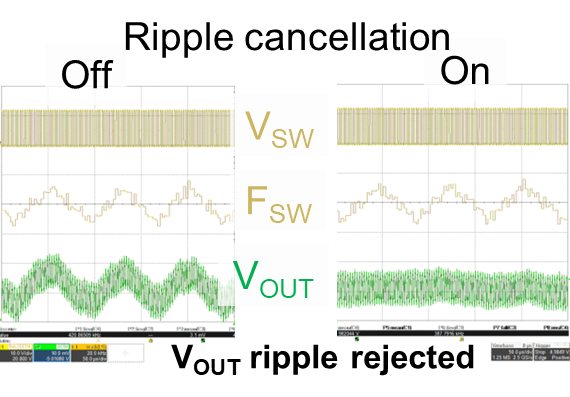SLUP408 February 2022 LM25149-Q1 , LM61460-Q1 , LM61495-Q1 , LMQ61460-Q1
- 1 Introduction
- 2 Defining EMI
- 3 What Causes EMI in a Switched-Mode DC/DC Regulator?
- 4 Existing Passive EMI Filtering Techniques
- 5 Passive Filter Limitations
- 6 AEF
- 7 Spread Spectrum
- 8 DRSS
- 9 True Slew-Rate Control
- 10HotRod™ Package Technology
- 11Optimized Package and Pinout
- 12Integrated Capacitors
- 13Conclusions
- 14References
- 15Important Notice
8 DRSS
DRSS combines triangular spread spectrum with random modulation of the triangular modulation frequency, with pseudo random added on top [4]. Figure 8-1 shows an example of a DRSS modulation profile. The combination of triangular and pseudo random takes the best from both schemes, while the additional modulation of the triangular modulation frequency spreads the audible tone.
 Figure 8-1 A DRSS modulation waveform is
a combination of triangular and pseudo random, while the triangular modulation
frequency is randomly modulated as well.
Figure 8-1 A DRSS modulation waveform is
a combination of triangular and pseudo random, while the triangular modulation
frequency is randomly modulated as well.DRSS will still have audible noise spread among the tone, thus necessitating the need for an active ripple cancellation scheme. The modulation of the switching frequency changes the converter’s ripple current because of how quickly the switching period can change compared to the time it takes for the control loop to adjust to the switching frequency change. The changing ripple current creates an average output-voltage ripple that follows the frequency modulation. The active ripple cancellation will scale the peak current command inverse to the switching frequency timing to reject this ripple.
Figure 8-2 shows both the modulation and output voltage ripple with active ripple cancellation on and off. Without ripple cancellation, the output voltage follows the modulation frequency.
 Figure 8-2 Effect of spread spectrum on
the output ripple: without ripple cancellation, the output ripple will follow
the spread-spectrum modulation shown on the left; ripple cancellation shown on
the right cancels this unwanted effect.
Figure 8-2 Effect of spread spectrum on
the output ripple: without ripple cancellation, the output ripple will follow
the spread-spectrum modulation shown on the left; ripple cancellation shown on
the right cancels this unwanted effect.